
Pages 42-61
Some Variations and Exceptions
Canker rots have yet another pattern of decay. After the canker rot fungus becomes established, it forms a pressure pad that kills the cambium, thus enlarging the wound. The tree responds by compartmentalizing each new wound. These fungi may kill a tree by girdling. (figs. 78 -79)


Fomes chrysoloma on white fir.
Pages 42-43
Some decay-causing fungi can attack and kill roots that have not been wounded. But, these fungi may be compartmentalized as they grow from the roots upward into the trunk. The trees attacked by these fungi are often stressed or weakened by other factors first. (figs. 80-81)

(Below 1. Fruit body 2. Rhizomorphs)

Pages 44-45
Other species of decay-causing fungi usually attack wood after the tree has
been made into a product. In some cases the patterns of
decays in the product will still follow the patterns set while the tree was
alive. (figs. 82-83)
- - -
Figure 82
1. Hot spot for decay in poles, 6 inches above and 18 inches below ground.
2. Typical patterns of internal decay in poles: A, shell; B, wedge; C, inbetween; D, central; E, complete.
3. Typical patterns of external decay in poles: A, surface rot; B, soft rot.

Below - Figure 83
1. Lentinus lepidius, a destructive fungus.
2. Color change associated with stub.
3. Ring shake associated with wound.
4. Decay starting above and below stub-typical in-between pattern common in southern yellow pine.

Pages 46-47
Some Additional Details on the Expanded Concept of Tree Decay Decayed Wood
The Breakdown of Ordered Wood Results in Disordered Material.
DISCOLORATION is a process. DECAY is a process. DISCOLORED and
DECAYED wood represent the DISORDERED PRODUCT of an ORDERED material.
DISCOLORED WOOD results from an alteration of cell contents. There is only
slight or no loss of strength. The tree AND the microorganisms are
involved in the processes that result in discolored wood.
DECAYED wood is a result of a breakdown of cell walls. There is a great
loss of strength.
Many microorganisms are involved in the processes that result in decayed wood. The wood cells have been killed and the decay-causing microorganisms compete among themselves for the dead matter. Many factors affect the rate of decay. The TREE has the greatest influence in the LIMITS of the decay column. Most of the events in the decay process are ORDERED. The classical concept of decay deals mostly with disordered events. It is impossible to regulate disorder.
The expanded concept of decay deals primarily with ORDERED events. The ordered system of trees and microorganisms is constantly impacted by many types of ordered and disordered events: Temperature extremes for short periods, moisture extremes for short periods, changing soil elements, storms, fires, logging operations, soil compaction, flooding, earthquakes, soil grade changes, pollution, chemicals, gas leakage, human-caused epidemics, or diseases and insects.
These factors alone or in combinations greatly affect the MICROORGANISMS and the TREE. The factors may alter the rate of the decay processes but not the patterns of successions and compartmentalization, which are ordered events.
For example.
1) SUCCESSIONS, an ORDERED process, often determine RATE. Upset the normal successions and the process will be stalled (not stopped). This can be done by purposely infecting wounds with microorganisms that normally occur late in the succession, such as with species of Trichoderma. The decay process will be stalled.
2) COMPARTMENTALIZATION represents order. Some trees have a stronger wound response than others; they can compartmentalize invaded tissues more effectively than other trees of the same species. The differences are shown in the next three illustrations.
Page 48
When drill holes are inflicted in strong compartmentalizers, a pattern like this results-very short vertical columns and little to no lateral extension. (fig. 84)

When drill holes are inflicted into moderate compartmentalizers, a pattern like this results-long vertical columns and some lateral extension of discolored wood. (fig. 85)

When drill holes are inflicted in weak compartmentalizers, columns that look like this are seen-long vertical columns and complete lateral extension of discolored wood. (fig. 86)

The tree's response in the compartmentalization of discolored wood appears to be under strong genetic control.
Page 49
Wood Is Altered by Microorganisms in Five Basic Ways.
There are, of course, many variations to the five basic themes.
Discolored wood. Color of the wood is changed when cell contents are altered.
Bacteria--anaerobic, aerobic, and facultative forms--and non decay fungi usually are involved in these processes, but decay fungi can also be involved.
Some genera of fungi commonly associated with discolored wood are: Ceratocystis, Fusarium, Trichocladium, Hypoxylon, Graphium, Phialophora, Leptographium, Alternaria, Pullularia, Torula, and Rhinocladiella. Also associated are species of Fomes and Polyporus. Plugging in vessels can impart a color change, a vertical type of discoloration, but most color changes result from alteration of cell contents in ray parenchyma (radial discoloration). Some slight discolorations can result from the reaction of the tree alone to a wound, but intense discoloration usually involves the interaction of microorganisms with living and dying cells in the tree.
Blue stain fungi in white pine- tangential section through discolored rays. Bacteria are clustered near pits. (fig. 87)

Blue stain fungi in white pine-radial section through discolored rays. Bacteria are clustered in the ray cells. (fig 88)

(Below) Transverse section through discolored wood surrounding decayed wood
in Populus tremuloides (see page 22, fig. 30)
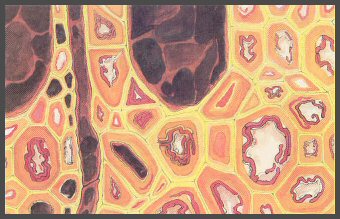
Figure 89
(Below) Radial section of discolored rays in red maple.


Figure 91
Click here for enlarged Figure 91
Pages 50-51
White rot.
The cellulose and lignin are digested at about equal rates. The digestion usually starts from the cell lumens and proceeds towards the middle lamella. Hymenomycetes are involved mostly, although species in the Xylariaceae also are associated with white rot (genera-Hypoxylon, Xylaria, Daldinia). There are many types of white rot (fleck. stringy, ring, pocket. etc.). These terms describe their macroscopic appearance. White rots occur also in wood products such as utility poles. Some of the most damaging fungi associated with white rots are Phellinus pini, Armillariella mellea, Fomitopsis annosa, Ganoderma applanatum, Oxyporus populinus, Phellinus igniarius, Innotus glomeratus, I. obliquus. and Echinodontium tinctorium. (figs. 92-94)

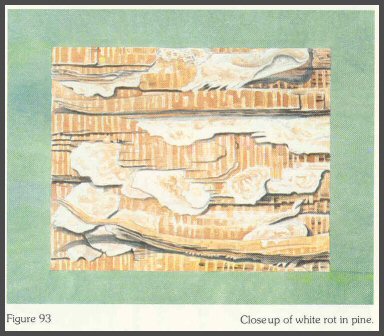
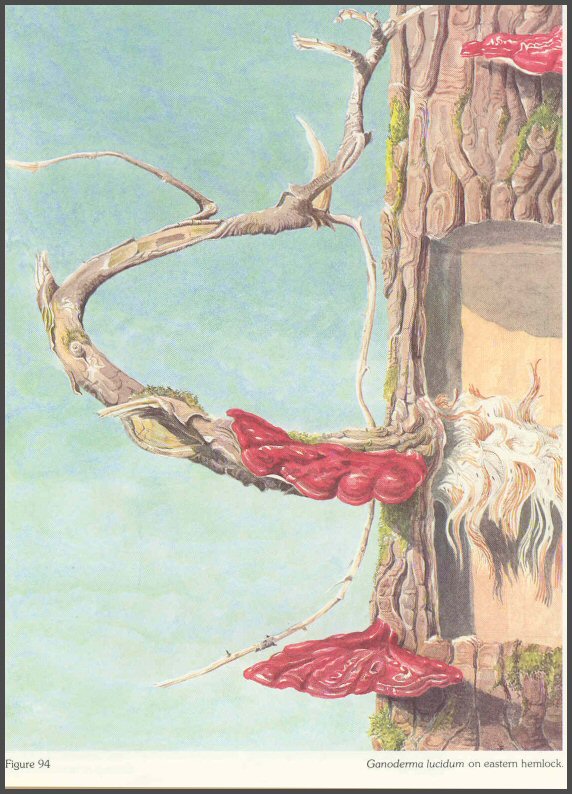
Pages 52-53
Brown rot.
The cellulose is digested preferentially. and the lignin is only altered slightly in this type of rot. Brown rots have a shrunken cubical appearance. Brown rot occurs mostly in gymnosperms and in wood products. Some common fungi associated with brown rots are Phaeolus schweinitzii, Poria monticola, Lentinus lepideus, and Polyporus betulinus, Polyporus sulphureus and Fomes pinicola are examples of fungi that cause the less common brown rot in angiosperms. (figs. 95-96)
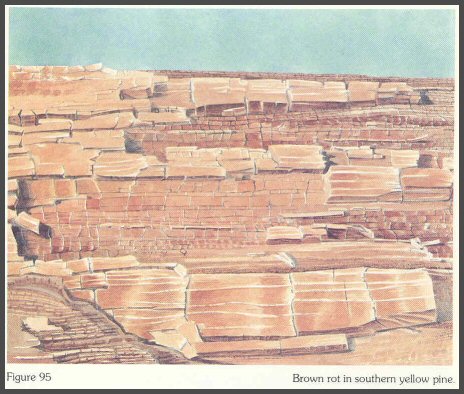

Page 54
Soft rots.
The S2 layer of the middle cell wall is digested by some microorganisms. (fig
97) Several patterns of digestion occur: Rhomboid cavities. (fig. 98) long
spindle- shaped cavities, and a general breakdown of the S2 layer. Many
variations occur. The causal fungi are usually nonhymenomycetes -
Phialophora, Penicillium, Chaetomium, etc. Soft rots occur mostly in
moisture-saturated angiosperm wood products. Little is known about soft
rots in living trees.
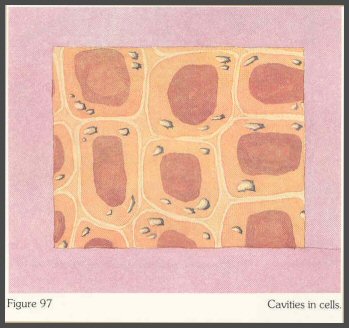
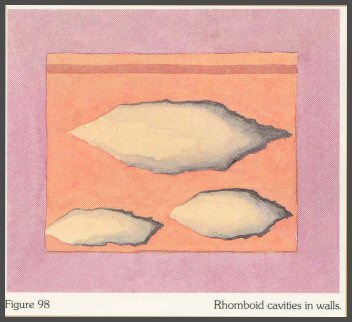
Bacterial alteration.
Little is known yet about the effects of bacteria alone on wood. In ponded logs, bacteria do invade pits-mostly the microfibrils of the pit margos. Under some conditions, bacteria have been known to digest some cell wall constituents. Some bacteria genera commonly associated with this type of wood alteration are Pseudomonas, Bacillus, and Clostridium. Bacteria are often intimately associated with fungi in the decay process. Many bacteria are facultative forms. (fig. 99)

Page 55
Wetwood.
Bacteria are the major organisms associated with a wood condition called wetwood. The infected wood mayor may not be darkly discolored. The infected wood may have a bleached or glassy appearance. (figs 100-101)


Page 56
Slash Deterioration
Dead wood on the forest floor is inhabited by a wide variety of microorganisms that continue their activities until the wood is completely decomposed. The microorganisms compete among themselves under constantly changing environmental conditions. (fig. 102)

Figure 102
Page 57
The Following Series of Paintings are Designed to Move the Mind's Eye Into a Tree Through a Wound.
Reference is made again to size relationships because as large as trees are, the decomposition processes are developing at the microscopic level with the microorganisms and the tree cells.
A large fresh basal wound on a mature sugar maple. (fig. 103)
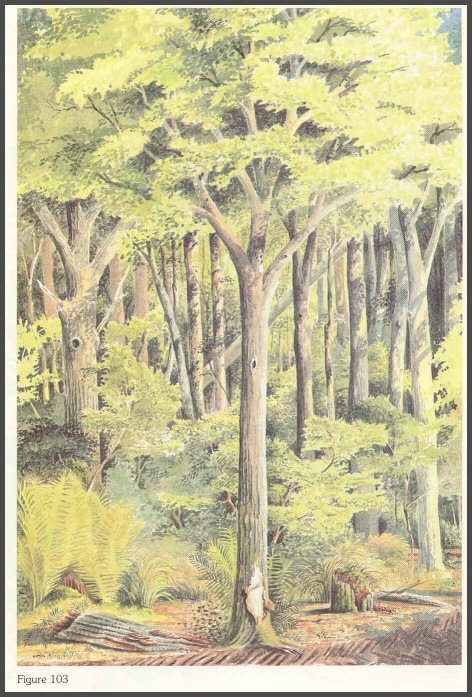
The bark has been torn and the wood is injured deep into the trunk. (fig. 104)

The crushed wood at the surface of the wound contains debris and broken pieces of mosses, lichens, and other plants. Small droplets of moisture begin to ooze from the tree. (The red block shows the section magnified in the next painting.) (fig. 105)
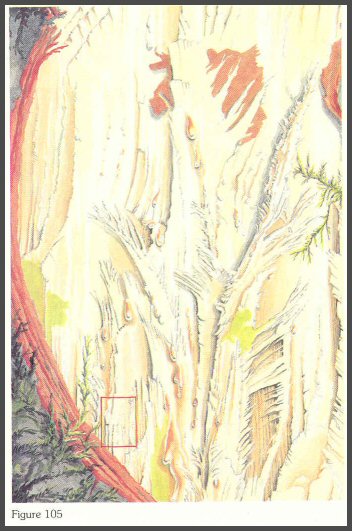
Pages 58-59
Each minute droplet of moisture is like an enormous ocean to the microorganisms. Each minute crack is like several grand canyons in width to the microorganisms. The wound surface is made up of thousands of micro sites for growth of microorganisms. (fig. 106)
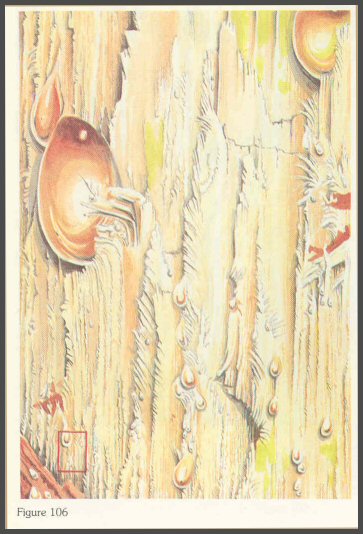
The minute droplets, too small to be seen by the human eye, are sites for groups of microorganisms to begin growth on the wound. Each droplet is a storehouse of nutrients. The microscopic wood splinters are excellent places for propagules of microorganisms brought in by wind, rain, and insects. The broken tangential faces of the ray sheets begin to show. The broken and crushed ray cells make INFECTION easy for the microorganisms. (fig. 107)
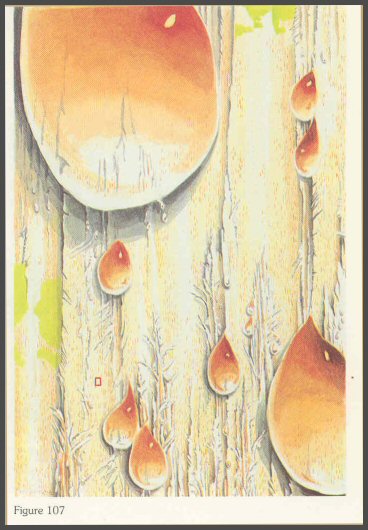
(Below) The minute droplets now appear as gigantic globes. After several weeks, many bacteria and fungi begin to grow into the broken wood cells-this is infection. Here a vessel is being infected by nonhymenomycetous fungi and groups of rod-shaped bacteria. Some fungi are also growing into the broken wood cells. Competition for this new space and for the abundance of nutrients is intense. The tree exerts little or no protective force here because the cells have been injured severely or killed by the wound. (fig. 108)
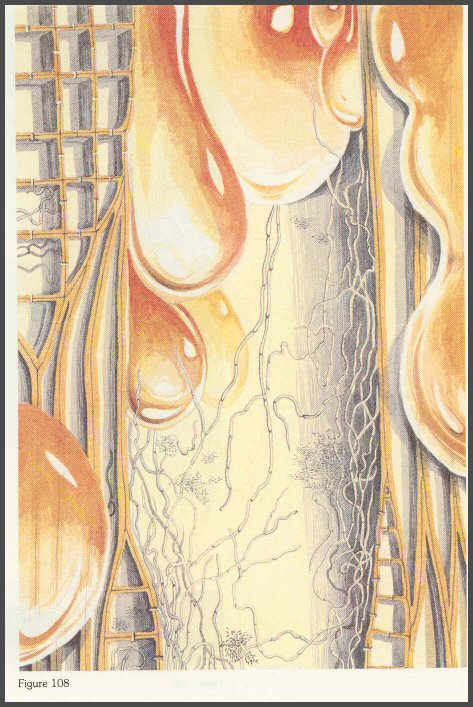
Pages 60-61